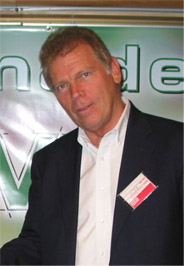Devoid of a woofer and tweeter, Norris’ HSS system consists of an emitter measuring as little as one-sixteenth of an inch thick, digital processor and amplfier. Designed to control the direction of sound emitted, HSS is focused like a laser beam. When aimed directly at a listener it has the effect of wearing headphones, almost like a voice inside one’s head. It projects high-frequency sound in the air, which produces ultrasonic waves that can also be made to bounce off walls or other objects, unlike conventional speakers which are larger and typically require a box. The sound is clearer and remains at the same level for all listeners over great distances, since it does not radiate in all directions like a conventional speaker. HSS is already being used for targeted messaging and capturing customer attention with sound, with additional applications targeted for the future, such as surround sound in home theaters. A side benefit of HSS is that people can move aside from the sound beam if they don’t want to listen. Norris has taken to flight with his latest brainchild, the AirScooter (still being fine-tuned). Mostly computer operated with handlebar assistance, this personal transportation vehicle weighs just over 250 pounds and does not require a license to fly; it can be mastered in a weekend. The AirScooter has two counter-rotating blades and two pontoons, and his company plans to offer an optional GPS navigational system in the future. While originally envisioned for recreational users, it has also sparked the interest of law enforcement officials and general commuters. Inspired by Doppler radar, Norris in 1967 created a sonar tool to isolate different movements inside the human body. This Transcutaneous Doppler system, which sends ultrasound through the skin, was designed to listen to targeted sounds, and was a precursor to the sonogram. In the mid-1980s, Norris created a hands-free ear-mounted speaker/microphone device operating on the principle that sound travels through the bones in a persons head. The device was designed at the request of NASA, as a replacement for the built-in microphone in helmets used by astronauts. A commercial version, produced by JABRA Corporation, is now the most popular cell phone headset, with sales estimated in excess of one hundred million per year. Another invention by Norris is Flashback® the first handheld recording and playback device that eliminated audio-tape. It uses non-volatile flash memory and is totally solid state—no moving parts. Norris, who grew up in Cumberland, Md., attributes some of his success to his high school drama group which developed his public speaking and confidence and even earned him a national thespian award. Norris has garnered 47 U.S. patents, several of which are harnessed in his company American Technology Corporation. Devoted to inspiring kids, he continues to speak at schools, while working on his inventions. (republished from http://web.mit.edu/invent/a-winners/a-norris.html) |

